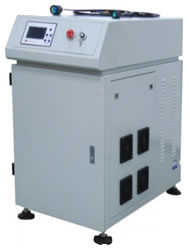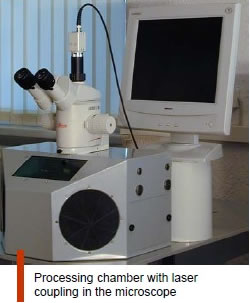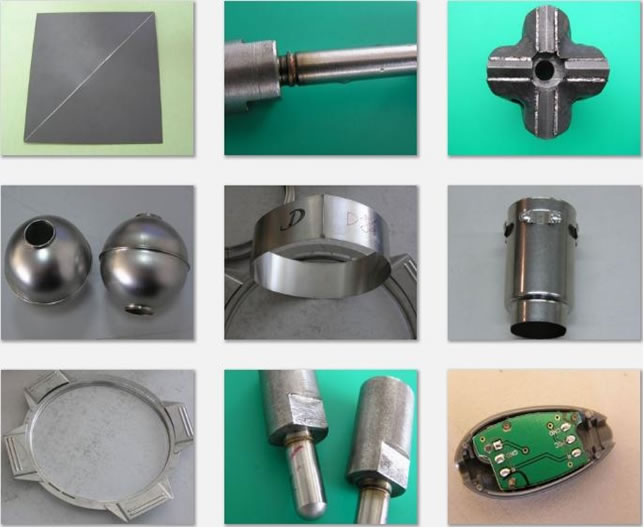|
1.
Fiber-delivered
Laser Welding Machine

The optical fiber delivery laser welder is a kind of
laser welding equipment that couples the high energy laser beam into the
optical fiber, collimates to parallel light by collimating lens after
long distance transmission, and then focuses on the work piece to weld.
For the positions hard to reach, implement flexible noncontact welding
to have more flexibility. The laser beam can realize spectroscopy in
time and energy and process multiple light beams simultaneously, making
more precise welding possible.
Features:
1.
CCD monitor system is equipped for observing and
precision positioning.
2.
The welding spot energy distributes evenly and has the
perfect light spots required by welding characteristics.
3.
Suitable for complex welds, spot welding of different
devices and seam welding of thin plates within 1mm;
4.
Ceramic converging cavity is imported from the Britain.
It is corrosion resistant and high temperature resistant, and has 8-10
years service life. The life of xenon lamp is more than 8 million times.
5.
Automatic tooling fixtures can be customized to realize
mass production.
|
Model |
WF300 |
|
Laser wavelength |
1064nm |
|
Laser working substance |
Nd:YAG |
|
Pulse width |
≤40ms |
|
Pulse frequency |
≤80Hz |
|
Optical fiber diameter |
0.4mm/0.6mm |
|
Minimum welding spot diameter |
0.2mm |
|
Rated laser power |
300W/400W |
|
Optical fiber output quantity |
Both energy spectroscopy and time spectroscopy
are available; standard optical fiber: one line, up to six lines |
|
Cooling system |
Water cooling |
|
Power supply |
380VAC�10%/50Hz, 14kW |
|
Dimensions |
1200x600x1100mm |
|
Weight |
300kg |
Laser welding is the most flexible and modern method to
join together different materials. With STCP welding machine, it is
possible to weld together metals, such as steel, stainless steel,
platinum, gold, titanium, brass, bronze, nitinol, and other alloys, as
well as semiconductors and other diverse materials, without the use of
solder or soldering flux.
The latest laser technology along with modern control
techniques and ease of maintenance are all combined in this pulsed
laser-welding system. This system is developed mainly for
micro-processing and, highly suitable for applications in research and
development as well as in small-scale manufacturing.
The welding system is available as a beam source (laser
class IV) or with a sealed processing chamber (laser class I). The
software of the laser welding system runs under the operating systems
Windows 95/98, Windows NT, and Windows 2000/XP.
The beam source is a pulse-driven Nd:YAG laser that emits
light with a wavelength of 1064nm. The laser energy is transmitter
through a quanrtz-glass fiber and is focused on approximately 100um.
Features:
�
High beam quality and efficiency even with the smallest
focal diameters
�
Flexible integration into a processing station with laser
class I for micro-processing
�
High system reliability through durable components and
low maintenance
Applications:
�
Micro-welding
�
Micro-drilling
�
Micro-perforating
�
Photo-labelling
�
Photo-induced reactions
Specifications:
|
Wavelength |
1064nm |
|
Pulse energy |
0-4000mJ |
|
Pulse width |
0.1-5.0ms |
|
Mode |
Multimode |
|
Focus diameter |
200um(standard optics), 100um/50um (special
optics) |
|
Output power |
5W (average) |
|
Charging power |
300W |
|
Pilot laser |
1mW at 633nm |
|
Pulse frequency |
1Hz at maximum energy |
|
Quartz-glass fiber |
200um core diameter, 1.5m length |
|
Cooling |
Internal, air-cooled water cycle |
|
Temperature range |
15�C-35�C |
|
Control unit |
Microprocessor with LCD display, separate control
panel, serial PC port, computer program for the control of all
laser functions. |
|
Dimensions |
520 x 520 x 280 mm |
|
Weight |
50kg |
|
Power source |
230V/115VAC � 10%, single phase, connected load
1kW |

Option 1: Stereo Microscope
In order to attain a very small focus, the beam of the
laser is coupled with a microscope. In this case, the high quality lens
of a Leica microscope is used to focus the laser beam. Thus, a
perpendicular observation of the workpiece is possible.
Option 2: Sealed Processing Chamber (Laser class I)
The sealed
processing chamber of laser class I allows for the manual positioning of
the workpiece. Inside the chamber there is a table with an adjustable
height that can be positioned in the focus of the microscope through the
use of two handles. The table has a thread-raster in order to fix the
sample holder or XY translation stage. The observation can take place
through the large protective window, the oculars of the microscope (with
integrated protective filters), or a monitor connected to an optional
CCD camera.
3. Welded Samples


|
